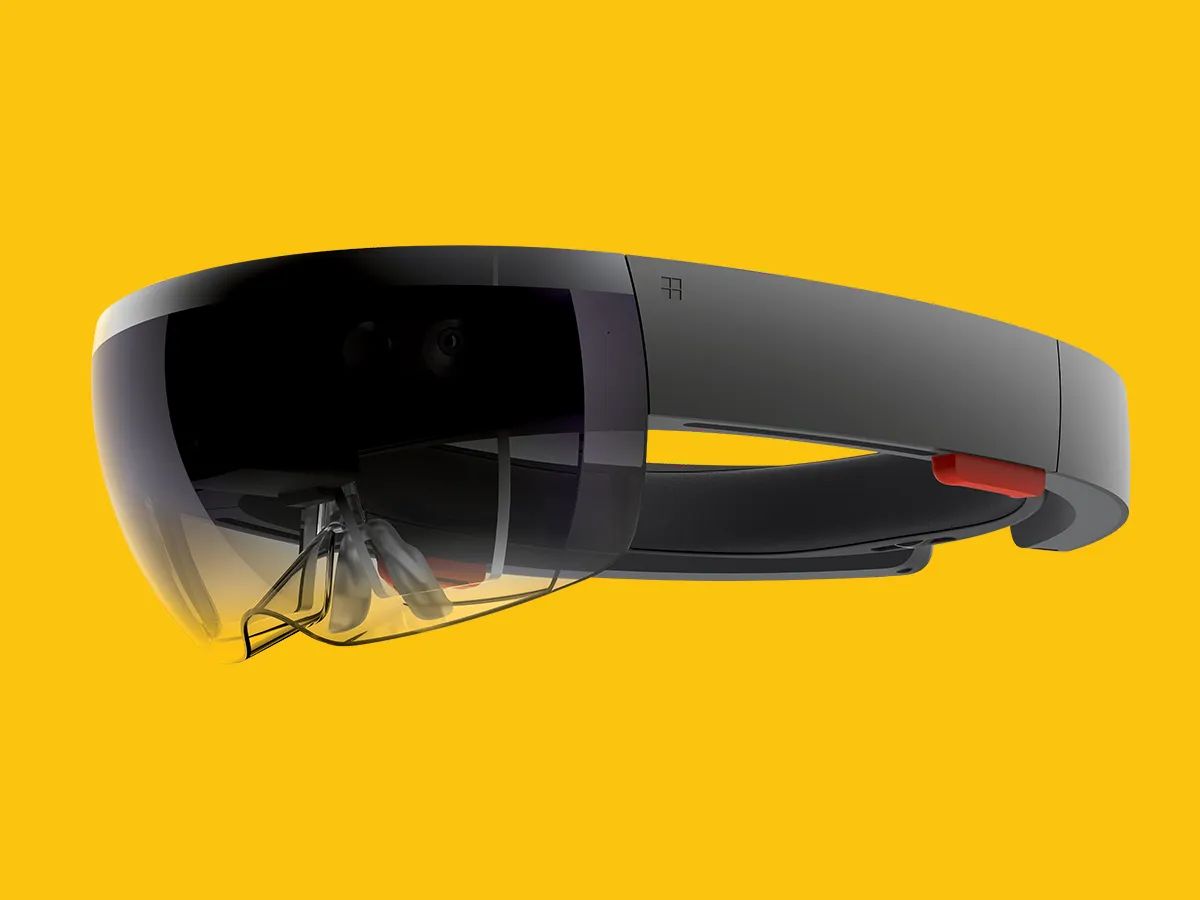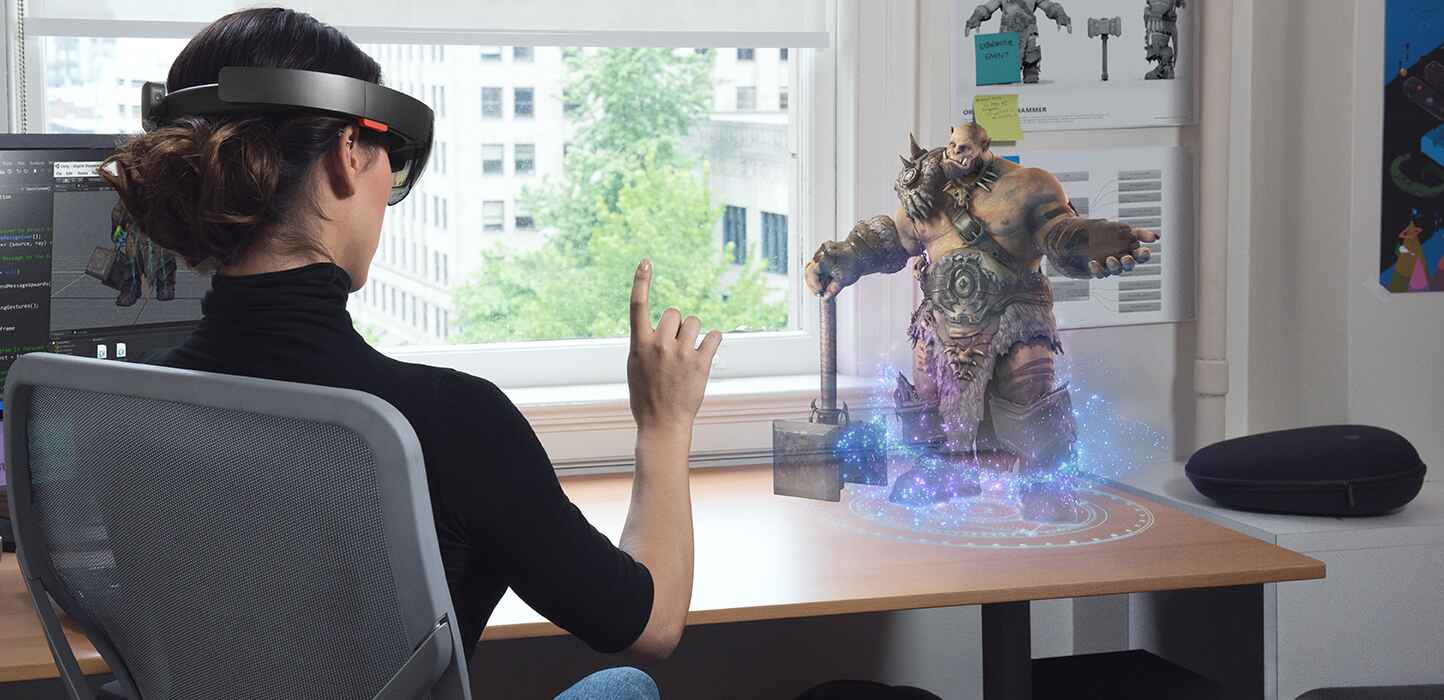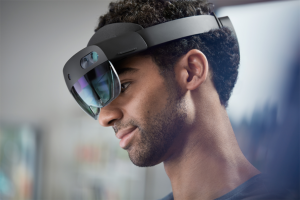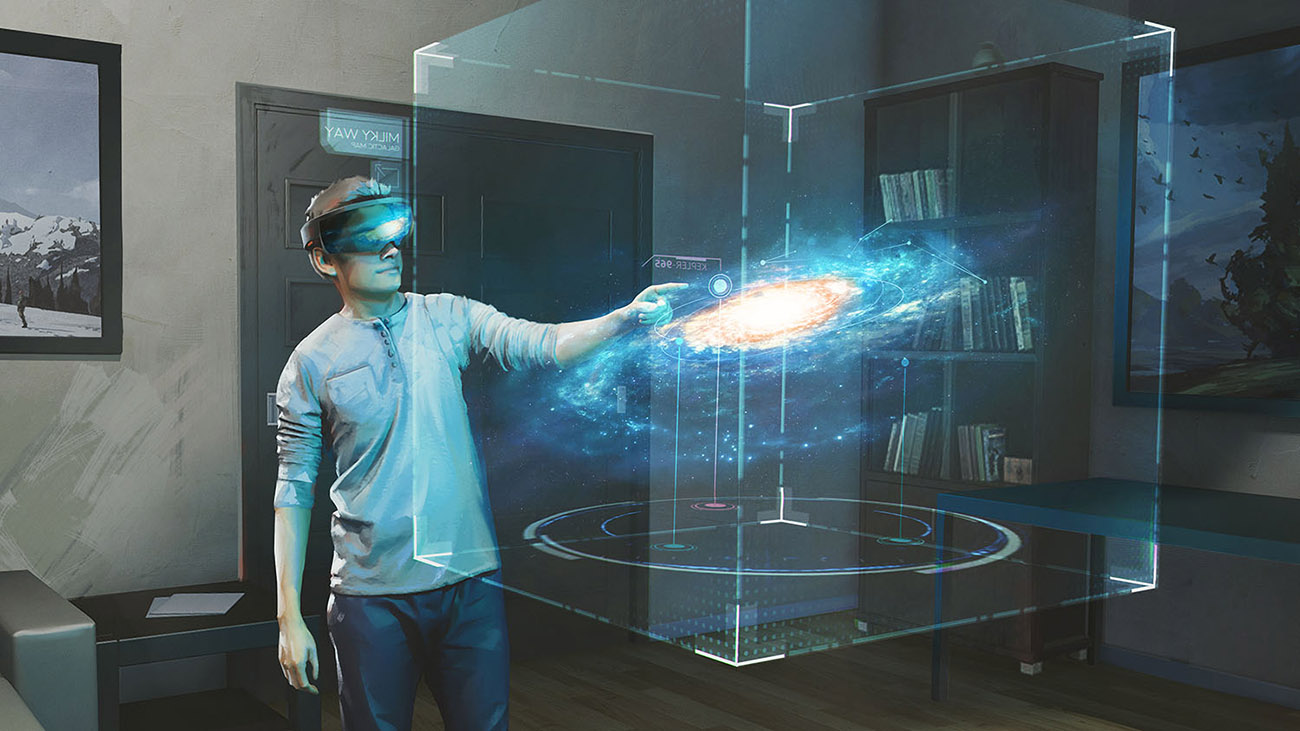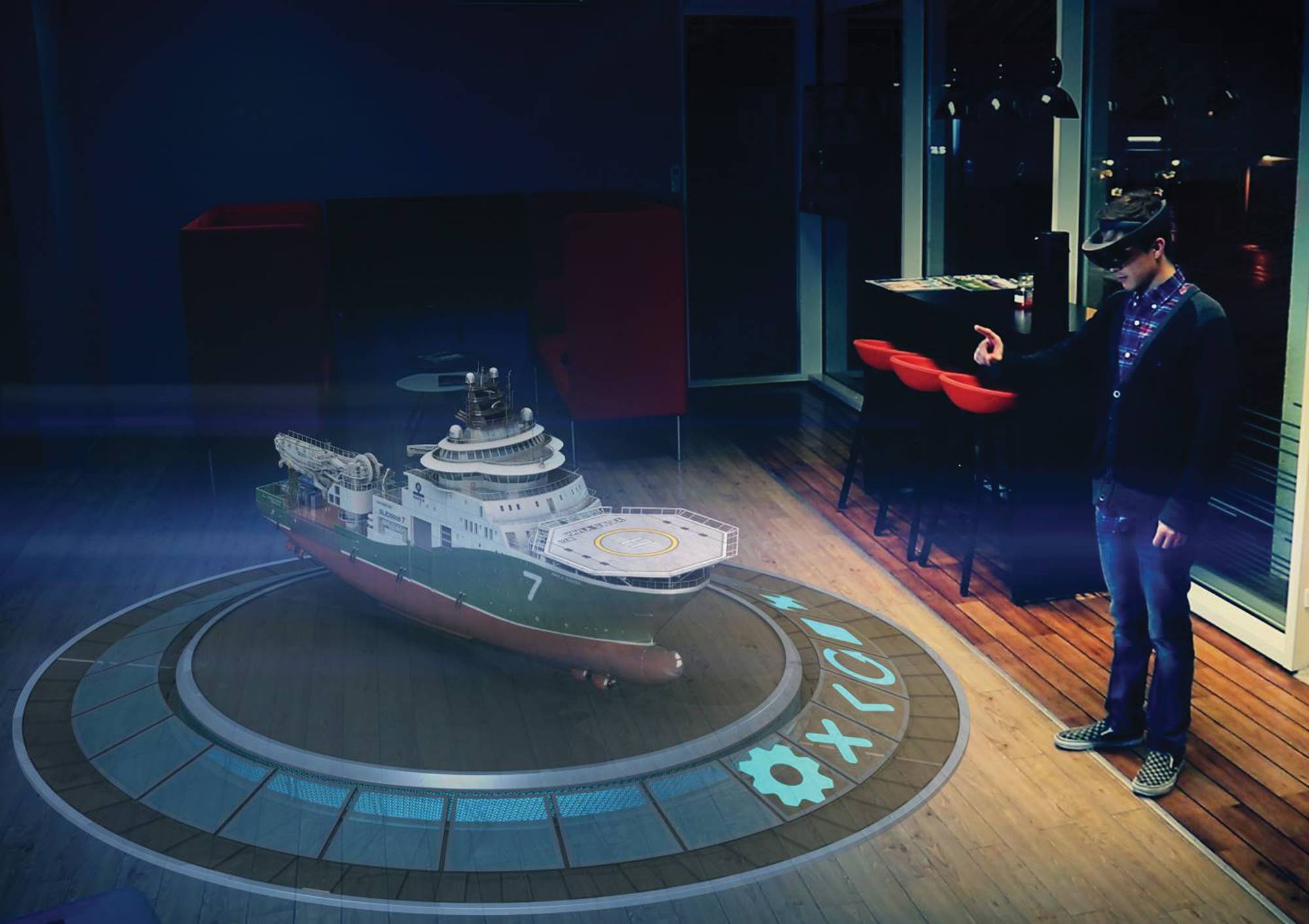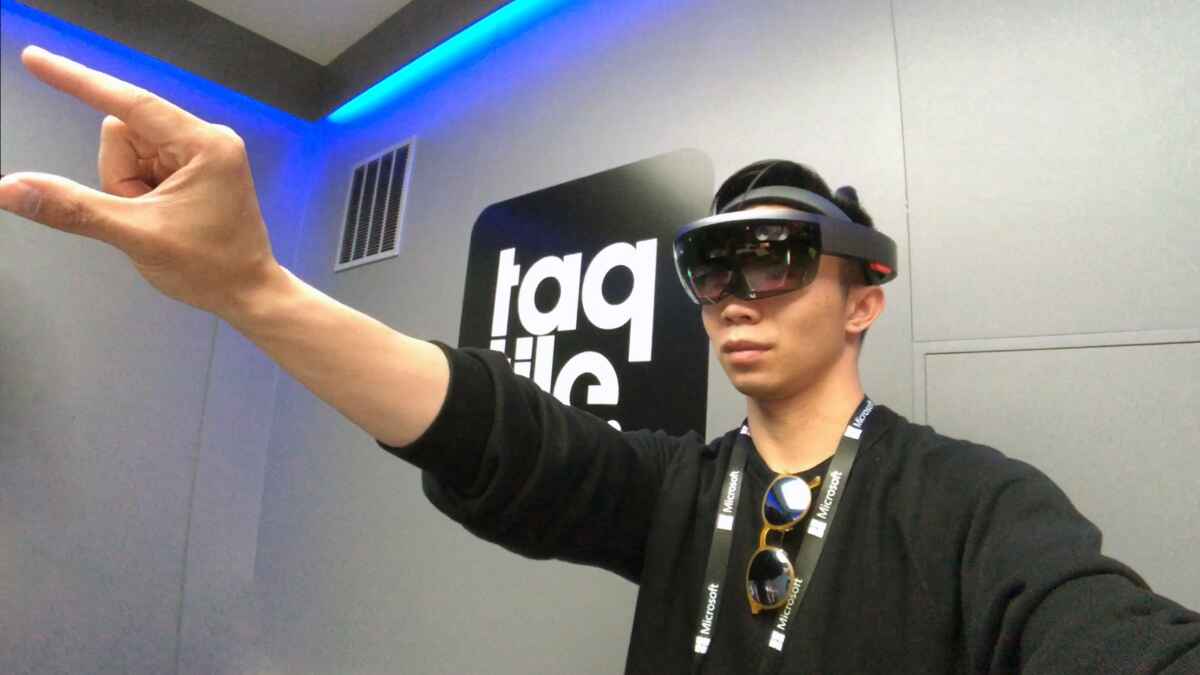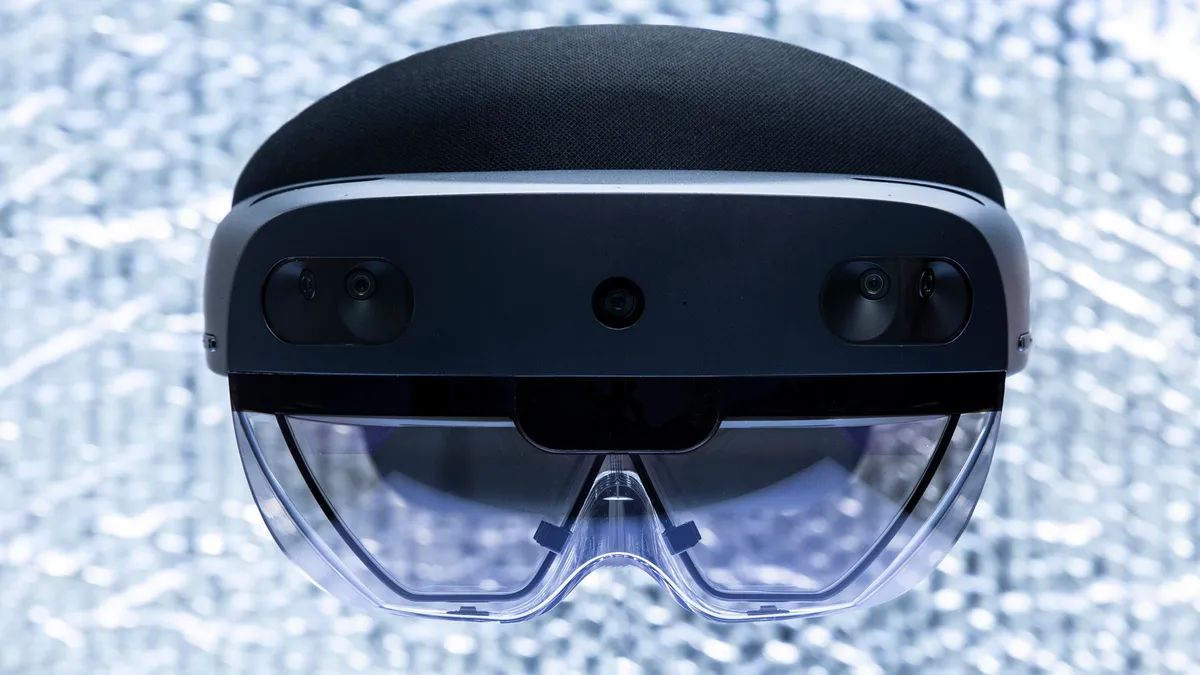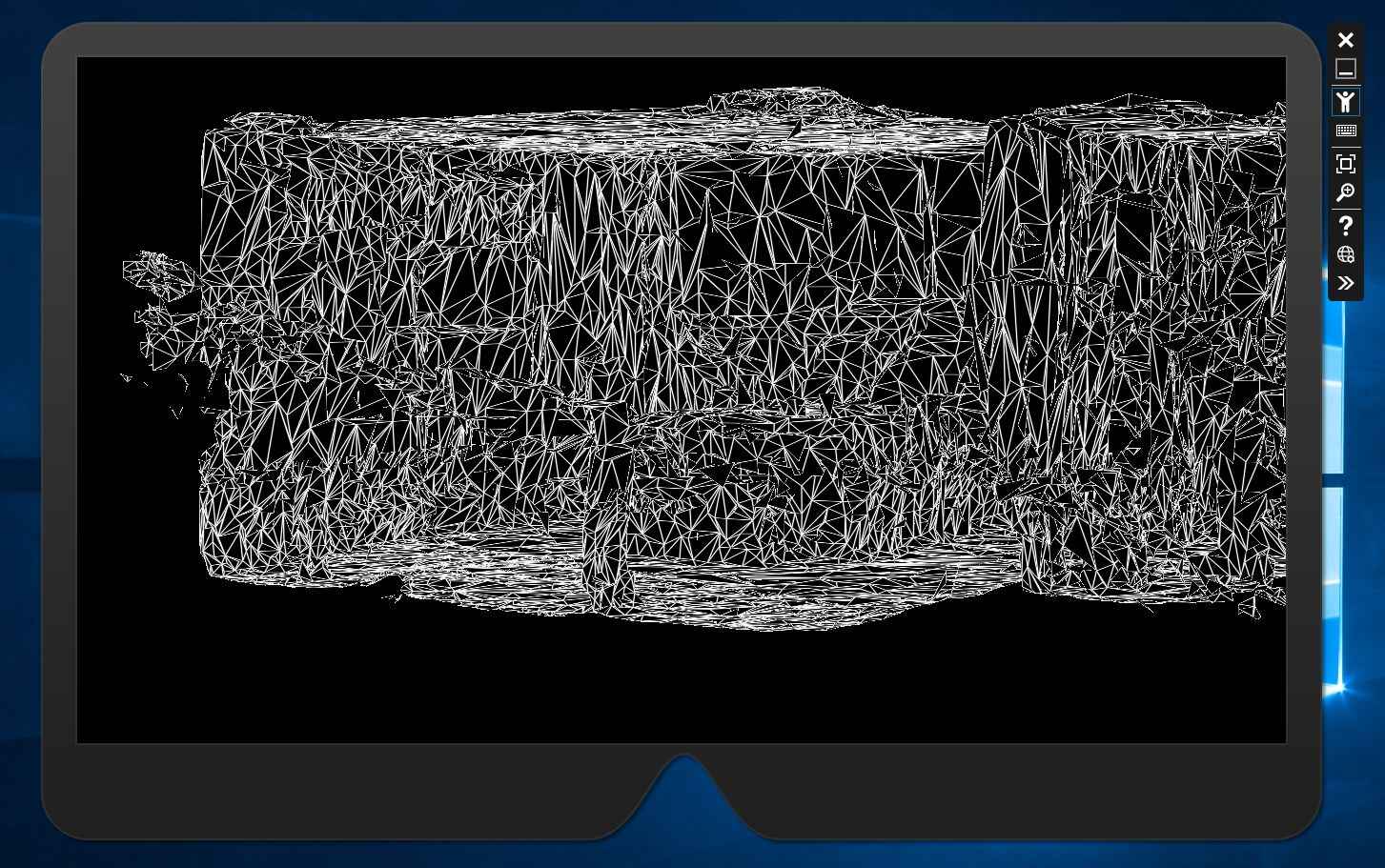Introduction
Welcome to the fascinating world of mixed reality, where the virtual and physical worlds seamlessly blend together. One of the most innovative and groundbreaking devices in this realm is the Microsoft HoloLens. Developed by Microsoft, the HoloLens is a state-of-the-art headset that allows users to interact with holographic objects and immerse themselves in a whole new dimension of computing.
Unlike virtual reality (VR), which creates a completely simulated environment, and augmented reality (AR), which overlays digital information onto the real world, the HoloLens introduces the concept of mixed reality. With the HoloLens, users can interact with holograms that are spatially aware, meaning they can be placed and manipulated in the real world.
The HoloLens consists of a combination of advanced hardware components, including sensors, cameras, and an optics system, along with intelligent software that enables gesture and voice recognition. This powerful combination allows users to experience holograms in a natural and intuitive way.
In this article, we will take a deep dive into the inner workings of the Microsoft HoloLens. We will explore the various components of the device, how it tracks and maps the user’s environment, and how it displays holograms. We will also delve into the operating system of the HoloLens and the process of developing holographic experiences for this revolutionary device.
So, whether you are a technology enthusiast, a developer, or simply curious about the future of computing, join us as we unravel the mysteries of the Microsoft HoloLens and explore the limitless possibilities it offers.
Understanding Mixed Reality
Before diving into the intricacies of the Microsoft HoloLens, it’s important to grasp the concept of mixed reality (MR) and how it differs from other types of virtual experiences. Mixed reality combines elements of virtual reality (VR) and augmented reality (AR) to create a unique and immersive digital environment.
Unlike traditional VR, which immerses users in a completely simulated world, MR allows users to interact with virtual objects in their real-world surroundings. This means that users can see and manipulate holographic objects while still being aware of and interacting with their physical environment. This blend of the real and the virtual creates an incredibly powerful and immersive experience.
Mixed reality also differentiates itself from augmented reality by contextualizing virtual elements within the real world. In AR, digital information is typically overlaid onto the user’s field of view, enhancing their perception of the real world. However, in mixed reality, holographic objects are seamlessly integrated into the user’s environment, creating the illusion of coexistence between the physical and virtual worlds.
The Microsoft HoloLens takes mixed reality to the next level by providing a self-contained, untethered wearable device that allows users to experience MR in a truly immersive and interactive way. Instead of relying on external cameras or tracking systems, the HoloLens has built-in sensors and cameras that enable precise spatial mapping and gesture recognition.
One of the key advantages of mixed reality is its potential to revolutionize various industries. In the field of architecture and design, for example, architects can visualize and modify 3D models of buildings in real-time, allowing them to make informed decisions during the design process. In education, students can embark on virtual field trips and interact with lifelike historical figures or explore distant planets, bringing learning to life in an engaging and dynamic way.
With an understanding of the concept of mixed reality, we can now delve deeper into the inner workings of the Microsoft HoloLens and discover how this groundbreaking device brings the virtual and physical worlds together in a seamless and intuitive manner.
The Components of the HoloLens
The Microsoft HoloLens is a marvel of engineering, combining advanced hardware and intelligent software to deliver a truly immersive mixed reality experience. Let’s take a closer look at the key components that make up this groundbreaking device.
At the heart of the HoloLens is a powerful custom-built holographic processing unit (HPU) that processes all the sensor data and runs the device’s operating system. The HPU is responsible for spatial mapping, gesture recognition, voice commands, and other essential functionalities that enable users to interact with holograms in the real world.
The device features a transparent visor made of a specialized holographic lens. This visor is what users see through when wearing the HoloLens. It allows for the projection of holographic images onto the user’s field of view while still maintaining visibility of the surrounding environment. The visor also provides a high-resolution display for an immersive viewing experience.
On the outside of the HoloLens, there are several sensors and cameras that enable the device to gather information about the user’s surroundings. These sensors include an array of depth sensors, an accelerometer, and a gyroscope. The depth sensors work together to create a detailed 3D map of the environment, allowing the HoloLens to accurately place holograms in real-world locations.
The HoloLens also features an impressive array of cameras. These cameras capture video and photos, enabling users to share their mixed reality experiences with others. The device’s built-in microphone array captures audio, allowing for voice commands and interaction with virtual assistants such as Cortana.
The HoloLens is a self-contained device, meaning it has its own built-in compute and storage capabilities. It features an onboard CPU and GPU, as well as an ample amount of RAM to handle the complex task of rendering holograms in real-time. Additionally, the device offers storage for holding holographic applications and files.
One notable component of the HoloLens is its audio system. The device utilizes spatial sound technology to deliver a fully immersive audio experience. This means that sound can appear to come from specific directions, making virtual objects feel even more realistic and interactive.
Understanding the components of the HoloLens gives us a glimpse into the advanced technology that enables the device to merge the virtual and physical worlds seamlessly. In the next section, we will explore how the HoloLens tracks and maps the user’s environment to create a truly interactive mixed reality experience.
Inside the HoloLens: Sensors and Cameras
One of the incredible features of the Microsoft HoloLens is its ability to understand and interact with the user’s surrounding environment. This is made possible through a sophisticated array of sensors and cameras that work together to sense the world in three dimensions, enabling the device to accurately place holograms in real-world locations.
The HoloLens is equipped with multiple depth sensors, including infrared (IR) sensors and a time-of-flight sensor, which work in tandem to create a detailed 3D map of the user’s surroundings. These sensors emit and detect IR light, which helps measure the distance to objects and create a depth map of the environment. This depth information is crucial for the HoloLens to accurately place holograms in the user’s field of view and ensure they interact seamlessly with the real world.
In addition to the depth sensors, the HoloLens also features an accelerometer and a gyroscope. These motion sensors track the movement of the user’s head, allowing the device to adjust the holographic images accordingly, so they appear stable and anchored in the user’s environment. This tracking capability enhances the overall immersion and realism of the mixed reality experience.
The HoloLens also incorporates several cameras that capture the visual information needed for spatial mapping and tracking. A high-resolution RGB camera captures color images of the user’s surroundings, providing visual context for the holograms. These images are used in conjunction with the depth data to create a comprehensive understanding of the environment.
Additionally, the cameras on the HoloLens enable the user to capture photos and videos of their mixed reality experiences. This allows for sharing and documentation of holographic interactions and adds an extra layer of collaboration and creativity to the device’s capabilities.
Another important aspect of the HoloLens is its built-in microphone array, which captures audio signals from the user. This array consists of multiple microphones strategically placed to detect and isolate sound sources. The microphone array enables users to give voice commands, interact with virtual assistants, and engage in voice-to-text communication while using the HoloLens.
Collectively, these sensors and cameras inside the HoloLens work in harmony to track the user’s movement and environment, create a precise 3D map, and enable accurate placement of holograms. This intricate system ensures that the virtual and physical worlds seamlessly merge, allowing users to interact with holograms as if they were real objects in their environment.
Now that we have explored the sensors and cameras inside the HoloLens, let’s delve into the remarkable technology that enables the device to track and map the user’s environment in detail.
Tracking Your Environment with the Spatial Mapping Sensor
The spatial mapping sensor is one of the key components of the Microsoft HoloLens that enables the device to understand and interact with the user’s environment. This sensor plays a crucial role in creating a detailed 3D map of the surroundings, allowing the HoloLens to accurately place holograms in the real world.
The spatial mapping sensor works by emitting infrared light and measuring the time it takes for the light to bounce back from objects in the environment. This information is then used to create a depth map, which represents the distances to different surfaces and objects. The sensor captures this depth data from multiple angles, allowing it to create a comprehensive representation of the environment in three dimensions.
Once the depth data is collected, the spatial mapping sensor uses advanced algorithms to analyze and interpret the information. It identifies surfaces such as walls, floors, tables, and furniture and creates a mesh representation of these surfaces. This mesh, known as the spatial map, serves as a digital model of the real-world environment.
The spatial mapping sensor continuously updates the spatial map in real-time as the user moves around and encounters new objects or changes in the environment. This ensures that the holograms generated by the HoloLens are responsive to the user’s surroundings and can interact seamlessly with the physical world.
One of the remarkable aspects of the spatial mapping sensor is its ability to handle dynamic environments. It can detect and accommodate changes in the environment, such as the movement of objects or people. For example, if a person walks in front of a hologram, the spatial mapping sensor can recognize the obstruction and adjust the hologram’s position or transparency to account for the new object in the scene.
The spatial mapping sensor also contributes to the safety and comfort of the user. By understanding the physical environment, the HoloLens can provide important cues and warnings to prevent collisions or other hazards. For instance, if a user is about to walk into a wall, the HoloLens can display a visual warning or provide audio cues to ensure the user’s safety.
Overall, the spatial mapping sensor is a critical component that underpins the mixed reality experience provided by the Microsoft HoloLens. By tracking and mapping the environment with precision, this sensor enables the HoloLens to seamlessly integrate holograms into the real world, creating a truly interactive and immersive mixed reality experience.
Next, let’s explore the optics system of the HoloLens, which is responsible for displaying holograms and bringing them to life in the user’s field of view.
Displaying Holograms with the Optics System
The optics system is a critical component of the Microsoft HoloLens that brings holograms to life and displays them seamlessly in the user’s field of view. This system comprises advanced optical technologies, including waveguides, projectors, and display engines, that work together to create a convincing mixed reality experience.
At the core of the optics system are the waveguides. These waveguides are transparent plates with specialized coatings that allow for the projection of holographic images onto the user’s field of view. The waveguides are responsible for directing and guiding light, ensuring that the holograms are properly displayed and integrated into the user’s environment.
When a hologram is generated by the HoloLens, it is projected onto the waveguide and travels through the optics system. The optics system then bends and reflects the light, using a series of mirrors and lenses, to direct the holographic image into the user’s eyes. This process ensures that the hologram appears like a natural part of the user’s surroundings.
The projection of the holographic image is done using projectors located within the HoloLens. These projectors emit light onto the waveguides, which then scatter and reflect the light into the user’s eyes. The projectors and the waveguides work in tandem to create a convincing and realistic presentation of holographic content.
One key aspect of the optics system is the display engine, which is responsible for rendering the holographic images with high resolution and fidelity. The display engine uses advanced optics techniques to ensure that the holograms appear sharp, vibrant, and in proper focus. This helps create a seamless integration of virtual objects with the physical world, enhancing the overall immersion and realism of the mixed reality experience.
The optics system of the HoloLens also accounts for the user’s individual interpupillary distance (IPD), which is the distance between their eyes. By dynamically adjusting the holographic display to match the user’s IPD, the HoloLens ensures that the holograms appear correctly aligned and comfortable to view, regardless of the user’s unique eye spacing.
In addition to the optics system, the HoloLens also employs a technique called “bionic display” to enhance the visual experience. This technique mimics how the human eye perceives light and helps create a wider field of view for the holographic content. This wider field of view allows for a more immersive and expansive mixed reality experience.
With its advanced optics system, the Microsoft HoloLens delivers holograms with unparalleled visual fidelity and integration into the user’s environment. The waveguides, projectors, display engine, and other optical technologies work seamlessly together to create a truly captivating mixed reality experience.
Now, let’s explore how users can interact with holograms using gesture and voice recognition, which are made possible by the HoloLens’ intelligent software.
Interacting with Holograms: Gesture and Voice Recognition
One of the remarkable features of the Microsoft HoloLens is its ability to enable intuitive and natural interactions with holograms. This is made possible through advanced gesture and voice recognition technologies, which allow users to manipulate and control virtual objects with simple hand movements and voice commands.
Gestures play a key role in interacting with holograms. The HoloLens is equipped with a range of sensors, including depth sensors and an infrared camera, that enable precise tracking of the user’s hand movements. By simply gesturing with their hands, users can select, resize, and move virtual objects, making it feel as if they are directly interacting with physical objects in their environment.
The HoloLens recognizes a variety of gestures, including air tap, bloom, and pinch. An air tap is performed by extending the index finger and tapping in the air in front of the user. This gesture is used to perform selections, clicks, and other actions within the holographic interface. The bloom gesture is executed by opening and spreading all fingers, similar to a flower blooming, and it serves as a way to bring up the Start menu and access other system-level commands. The pinch gesture involves using the thumb and index finger to pinch and manipulate holograms, making it ideal for resizing and rotating virtual objects.
Alongside gesture recognition, the HoloLens also incorporates powerful voice recognition capabilities. The device includes an array of microphones that capture audio signals and perform sophisticated speech recognition algorithms. Users can interact with the HoloLens by using voice commands to launch apps, navigate menus, and perform various actions. The device supports a range of voice commands, including commands to place and manipulate holograms, launch specific applications, and access system-level settings.
The combination of gesture and voice recognition provides users with a versatile and intuitive means of interacting with holograms. This natural and user-friendly interaction model allows for a seamless integration of virtual objects into the real world, enhancing the overall immersion and usability of the mixed reality experience.
Beyond gestures and voice commands, the HoloLens also supports traditional input methods such as gaze and click. Gaze input allows users to interact with holograms simply by looking at them for a certain duration. Click input is performed with the air tap gesture or a click on an external Bluetooth clicker, giving users additional options for interaction when more precision is required.
The ability to interact with holograms using gestures and voice commands unlocks countless possibilities across various industries and applications. From interacting with virtual objects in professional design and engineering scenarios to playing immersive augmented reality games, the HoloLens empowers users to engage with holographic content in a way that feels natural and familiar.
Now that we have explored how users can interact with holograms, let’s dive into the operating system that powers the Microsoft HoloLens.
The HoloLens Operating System
The Microsoft HoloLens relies on a specialized operating system (OS) designed specifically for mixed reality experiences. This dedicated OS, known as Windows Holographic, serves as the foundation for the device’s core functionalities and enables the seamless integration of holograms into the user’s environment.
Windows Holographic is a variant of the widely used Windows 10 operating system. However, it has been optimized and tailored to meet the unique requirements of the HoloLens hardware and the mixed reality ecosystem. It provides a comprehensive platform for developers to create and deploy holographic applications and experiences.
One of the key features of the HoloLens operating system is its ability to run multiple applications simultaneously in a multi-tasking environment. Users can switch between different holographic apps, interacting with them seamlessly as they navigate the mixed reality space. This flexibility allows for a more immersive and productive experience, enabling users to access information and perform tasks fluidly.
Windows Holographic provides developers with a set of powerful tools and APIs (Application Programming Interfaces) to create holographic applications. These tools include the HoloToolkit, which provides foundational components and utilities for building mixed reality experiences, and the holographic shell, which allows developers to leverage the device’s core functionalities, such as spatial mapping, gesture recognition, voice commands, and more.
The HoloLens operating system also supports universal Windows apps, which can run on a variety of devices, including Windows PCs, tablets, and smartphones. This compatibility opens up possibilities for cross-platform development, allowing developers to target a broader audience and leverage their existing Windows app ecosystem.
In addition to application development, the HoloLens OS offers built-in security features to protect user data and ensure a safe and trustworthy experience. The device includes Azure Active Directory integration, allowing organizations to manage user identities and access control effectively. Users can also take advantage of Windows Hello, a biometric authentication system that uses facial recognition to secure access to the HoloLens.
As the HoloLens evolves, Microsoft regularly releases updates to the operating system, providing new features, performance improvements, and bug fixes. These updates are delivered over-the-air and are seamlessly installed on the device, ensuring users have access to the latest capabilities and enhancements.
With its dedicated operating system, the Microsoft HoloLens provides a robust platform for developers and users to explore the possibilities of mixed reality. The Windows Holographic OS blends the power of Windows with specialized features and tools to enable a rich and immersive holographic computing experience.
Now that we have a deeper understanding of the HoloLens operating system, let’s explore the process of developing holographic experiences for this remarkable device.
Developing for the HoloLens: Creating Holographic Experiences
Developing holographic experiences for the Microsoft HoloLens opens up a world of possibilities for creators, designers, and developers. The HoloLens provides a powerful platform and a range of tools and resources to bring immersive mixed reality experiences to life.
One of the key tools for building holographic experiences is the HoloToolkit, a collection of libraries, scripts, and components that simplifies the development process. The HoloToolkit offers a variety of pre-built capabilities, such as spatial mapping, input handling, and gesture recognition, allowing developers to focus on the core aspects of their application.
Developers can leverage the popular Unity game engine, which has native support for HoloLens development. Unity provides a range of features and tools specifically designed for creating interactive and visually stunning holographic applications. With Unity, developers can easily import 3D assets, design interactive user interfaces, and leverage physics simulations to enhance the realism of the holographic experiences.
Another powerful tool for HoloLens development is Visual Studio. With its robust debugging and profiling capabilities, Visual Studio provides an integrated development environment (IDE) for creating, testing, and deploying holographic applications. Visual Studio supports a range of programming languages, including C# and C++, and provides features like live debugging and remote deployment to simplify the development process.
When developing holographic experiences, understanding the unique aspects of mixed reality is crucial. Developers need to consider how holograms will interact with the user’s environment and how users will interact with holograms. They must design intuitive interactions, use the HoloLens’ gesture and voice recognition capabilities effectively, and ensure that holograms are placed in the real world with precision and accuracy.
Testing and user feedback play a vital role in developing compelling holographic experiences. Iterative testing, both through actual usage and with user research, can help refine the application’s functionality, user interface, and overall user experience. Conducting user studies and gathering feedback from a diverse range of users can provide invaluable insights and lead to improvements in the application’s usability and performance.
Microsoft provides extensive documentation, tutorials, and sample projects to support developers in building holographic experiences for the HoloLens. The Microsoft Developer Portal offers a wealth of resources, including APIs, design guidelines, and best practices, to empower developers at every stage of their project.
Developing for the HoloLens presents an opportunity to unleash creativity and innovation. Whether creating immersive games, interactive training applications, or engaging educational experiences, the HoloLens provides a unique platform to captivate and engage users in ways previously unimaginable.
With the HoloLens, developers can create holographic experiences that blur the lines between the virtual and physical worlds, offering users truly immersive and transformative mixed reality encounters.
Now that we have explored the process of developing holographic experiences, let’s wrap up our journey and reflect on the limitless possibilities and exciting potential of the Microsoft HoloLens.
Conclusion
The Microsoft HoloLens represents a significant advancement in the world of mixed reality, offering users a captivating and immersive experience that seamlessly blends the virtual and physical worlds. With its advanced hardware components, including sensors, cameras, and an optics system, combined with an intelligent operating system and powerful development tools, the HoloLens unlocks endless possibilities for creators, developers, and users alike.
Through its understanding of mixed reality, the HoloLens goes beyond virtual reality and augmented reality, allowing users to interact with holograms in their real-world surroundings. The device’s spatial mapping sensor and advanced optics system work together to create a detailed 3D map of the environment and ensure holograms are seamlessly integrated into the user’s field of view. Users can interact with holograms using natural gestures and voice commands, enhancing the overall immersion and user experience.
The HoloLens operating system, Windows Holographic, provides a robust platform for developers to create holographic experiences. With tools like the HoloToolkit, Unity, and Visual Studio, developers can build interactive and visually stunning applications that leverage the device’s core functionalities. The development process involves considering the unique aspects of mixed reality, testing iteratively, and gathering user feedback to refine and improve the holographic experiences.
Whether in architecture, education, gaming, or other industries, the HoloLens has the potential to revolutionize how we interact with digital content and redefine our perception of reality. The possibilities are limitless, from designing 3D models in real time to exploring ancient civilizations in an immersive educational experience. The HoloLens empowers users to engage with the digital world in unprecedented ways.
As technology advances and the HoloLens continues to evolve, we can expect even more remarkable features and applications to emerge. The fusion of the virtual and physical worlds holds immense potential for innovation and transformation across various fields.
So, whether you are a technology enthusiast, a creator, a developer, or simply curious about the future of computing, the Microsoft HoloLens invites you to step into a new dimension of mixed reality. Witness the convergence of the real and the virtual, and unlock a world where imagination becomes tangible.







